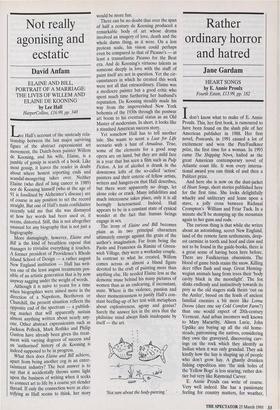Not really agonising and ecstatic
David Anfam
ELAINE AND BILL, PORTRAIT OF A MARRIAGE: THE LIVES OF WILLEM AND ELAINE DE KOONING by Lee Hall HarperCollins, £16.99, pp. 340 Lee Hall's account of the unsteady rela- tionship between the last major surviving figure of the abstract expressionist art movement, the Dutch-born painter Willem de Kooning, and his wife, Elaine, is a jumble of gossip in search of a book. Like most gossip, it leaves the reader in doubt about where honest reporting ends and scandal-mongering takes over. Neither Elaine (who died of lung cancer in 1989) nor de Kooning himself (who at the age of 91 is fossilised by Alzheimer's disease) are of course in any position to set the record straight. But one of Hall's main confidantes recently told me that she was dismayed at how her words had been used or, it seems, distorted. Still, this is not altogether unusual for any biography that is not just a hagiography.
More damagingly, however, Elaine and Bill is the kind of breathless exposé that manages to trivialise everything it touches. A former president of Providence's Rhode Island School of Design — a rather august New England institution — Hall has writ- ten one of the least august treatments pos- sible of an artistic generation that is by now anyway sagging under the weight of words. Although it is naive to yearn for a time when biographies were aimed more in the direction of a Napoleon, Beethoven or Churchill, the present situation reflects the opposite end of the spectrum — a publish- ing market that will apparently sustain almost anything written about nearly any- one. Other abstract expressionists such as Jackson Pollock, Mark Rothko and Philip Guston have already been given the treat- ment with varying degrees of success and an 'authorised' history of de Kooning is indeed supposed to be in progress. What then does Elaine and Bill achieve, apart from being another cog in an enter- tainment industry? The best answer is to say that it accidentally throws some light upon the business of writing when it seeks to connect art to life by a coarse yet slender thread. If only the connection were as elec- trifying as Hall seems to think, her story would be more fun.
There can be no doubt that over the span of half a century de Kooning produced a remarkable body of art whose drama involved an imagery of love, death and the whole damn thing, as it were. On a less protean scale, his vision could perhaps even be compared to that of Picasso's — at least a transatlantic Picasso for the Beat era. And de Kooning's virtuoso talents as someone deeply in love with the stuff of paint itself are not in question. Yet the cir- cumstances in which he created this work were not all that extraordinary. Elaine was a mediocre painter but a good critic who spent much time furthering her husband's reputation. De Kooning steadily made his way from the impoverished New York bohemia of the 1930s through the postwar art boom to his eventual status as an Old Master of modernism. In short, it looks like a standard American success story.
Yet somehow Hall has to tell another tale. She wants to scent a Lust for Life scenario with a hint of Amadeus. True, some of the elements for a good soap opera are on hand, but they are mild fare in a year that has seen a film such as Pulp Fiction. A lot of alcohol is drunk in the downtown lofts of the so-called 'action' painters and their coterie of fellow artists, writers and hangers-on that Hall describes, but there were apparently no drugs, let alone coke or crack. Many infidelities and much intercourse takes place, only it is all boringly heterosexual. Indeed, Hall appears to be in a constant state of cynical wonder at the fact that human beings engage in sex. The irony of Elaine and Bill becomes plain as its two principal characters ultimately emerge against the grain of the author's imagination. Far from being the Paolo and Francesca da Rimini of Green- wich Village, they were a workaday couple. In contrast to what he created, Willem comes across as almost a bland figure devoted to the craft of painting more than anything else. He needed Elaine less as the demonic muse behind his many pictures of women than as an endearing, if inconstant, mate. Where is the violence, passion and sheer momentousness to justify Hall's con- stant beefing-up of her text with metaphors about explosiveness, agony and genius? Surely the answer lies in the area that the philistine mind always finds inadequate by itself — the art.
`Not sure about the body piercing.'


























































 Previous page
Previous page